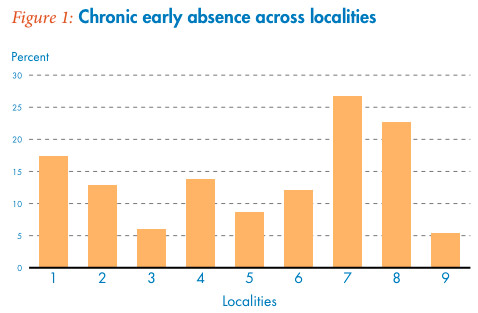The Tribune's big story this week is an excellent series on truancy in Chicago Public Schools. It's vividly reported and thoughtful in its scope, touching on the role poverty plays in the struggles of CPS students:
At Spencer, eighth-grader Janel Garrett started class more than a month late, just days before Curtis and more than a dozen others enrolled. Last year she missed more than two months at another elementary school, records show.
Her mother, Denise Smith, has felony convictions and lives in a West Side apartment on public aid. In the past, Smith said, she and her daughters have occasionally slept in public parks and in a car.
To enroll Janel at Spencer, Smith had to prove she was living in the area after moving from a West Side apartment outside the school's boundaries. That meant getting a new state ID, but she had trouble paying for it.
It's not just about truancy; it's about truancy as a symptom of deeper problems in CPS and in Chicago:
Ticking off a list of the seven Chicago public schools she has attended, Ledcke recounts living in shelters and bouncing around the country as her mother moved from Florida to Ohio, always returning to their native Bridgeport neighborhood.
[snip]
Earlier this year, Ledcke witnessed the knife slaying of a 29-year-old cousin outside a Bridgeport bar after a dispute over a love triangle, and she missed school when she testified before the grand jury.
It did make me curious how Chicago compared to other parts of the country. The city's not alone in its problems, though in some respects they're more severe. Would Chicago turn up worse truancy statistics than elsewhere? There actually isn't very good data; few states have rigorous metrics for truancy reporting, and the required metrics under No Child Left Behind are blunt: "The truancy rate merely indicates what percentage of students has been absent from school without a valid excuse for more than any 30-minute period during the school day on three occasions in one school year"
So 12.8 percent of K-8 CPS students miss at least four weeks of school. (K-8 is a conservative measurement, because truancy spikes during high school, for obvious reasons; there's a lot of variance in the K-8 figure based on race and disability, which the Trib did a nice job teasing out.) How does that compare to New York (PDF)?
The analysis presented in this report finds that chronic absenteeism in New York City begins in the earliest grades and is far more serious than has previously been reported. Our research found that more than 90,000 children in grades K through 5—or 20 percent of total enrollment—missed at least a month of school during the 2007–08 school year.
It varied a lot by region:
The center’s analysis of Department of Education (DOE) data found that more than 20 percent of the city’s elementary school pupils were chronically absent during the 2007–08 school year—that is, they missed at least 20 days of the 185-day school year. In districts serving poor neighborhoods, the numbers are even higher. In the south and central Bronx, in central Harlem, and in several neighborhoods in central Brooklyn, 30 percent or more of the pupils were chronically absent, according to the analysis. In contrast, only 5.2 percent of pupils were chronically absent in District 26, which serves the middle class neighborhood of Bayside, Queens.
In December, Catalyst did a report on early-grade absenteeism and found similar statistics [PDF]:
A Catalyst Chicago analysis of data from Chicago Public Schools shows that the problem of early absenteeism is widespread: Nearly 24,000 students in preschool through 3rd grade were chronically absent [10 percent of school days, or ~18] in 2009-2010—15 percent of all students at those grade levels. The rate may, in fact, be higher; in responding to Catalyst’s Freedom of Information Act Request, CPS redacted data from a number of schools.
Catalyst used data from the National Center for Children in Poverty, which ran into similar problems: a lack of data, and a lack of good data. They did manage to get data from nine different localities, for which they include demographic data but not names. Looking at K-3 chronic absence, here's what they found, using a minimum of 20 days as "chronic" (so, about the same metric as the Tribune):

Locality #7 is a decent proxy for CPS's racial mix: 39 percent Latino, 35 percent black, 9 percent white (CPS is 44/42/8). Locality #1 is an okay one for poverty: 28 percent live in high-poverty census tracts (33 percent of CPS students live in poverty). Locality #7 has 26.7 percent chronic absenteeism; locality #1, 17.4 percent.
Given the data that exists, Chicago is in the ballpark. That's not to say it's not a problem, just that it's a shared one. Because it's shared, as the Tribune reporters point out, we can learn from other cities.


